As the climate changes and the state, nation and world feel the devastating effects, researchers across the California State University are testing and pioneering methods to increase climate resiliency.
California Climate Action Seed and Matching Grants, administered through the University of California (UC) to drive climate action, are powering a sample of this extensive climate-related work, with funds supporting projects at 11 CSUs—Chico, East Bay, Humboldt, Long Beach, Monterey Bay, Northridge, Sacramento, San Diego, San Francisco, San José and San Luis Obispo.
“I am thrilled to see so many of our campuses working on the important problem of climate adaptation and action,” says Ganesh Raman, assistant vice chancellor for Research at the CSU Office of the Chancellor. “These grants allow our faculty to conduct research that is directly connected to the needs of our state by addressing key areas of climate action, including ecosystem resilience, workforce training, climate change mitigation and the effects on humans. Each of the funded projects also includes a community engagement aspect—with several projects allowing faculty to partner with local indigenous Tribes and to use indigenous knowledge to better protect our future.”
The grants were developed through a
historic partnership between the UC system and the state using funds set aside in the California State Budget Act of 2022-23. The UC distributed more than $80 million in grants across
38 projects. Recipients of Climate Action Matching Grants received between $2 million and $10 million, while Climate Action Seed Grant recipients were awarded between $500,000 and $2 million.
“With these investments, California is harnessing the ingenuity of our world-renowned universities and people to deliver climate action across our state,”
Governor Gavin Newsom said. “California is leading the charge in tapping our natural resources to protect our people, our communities and our planet.”
This Earth Day, we look at those funded CSU-led projects addressing critical climate challenges.
California Soil Carbon Accrual Project and Workforce Training Program | Chico State
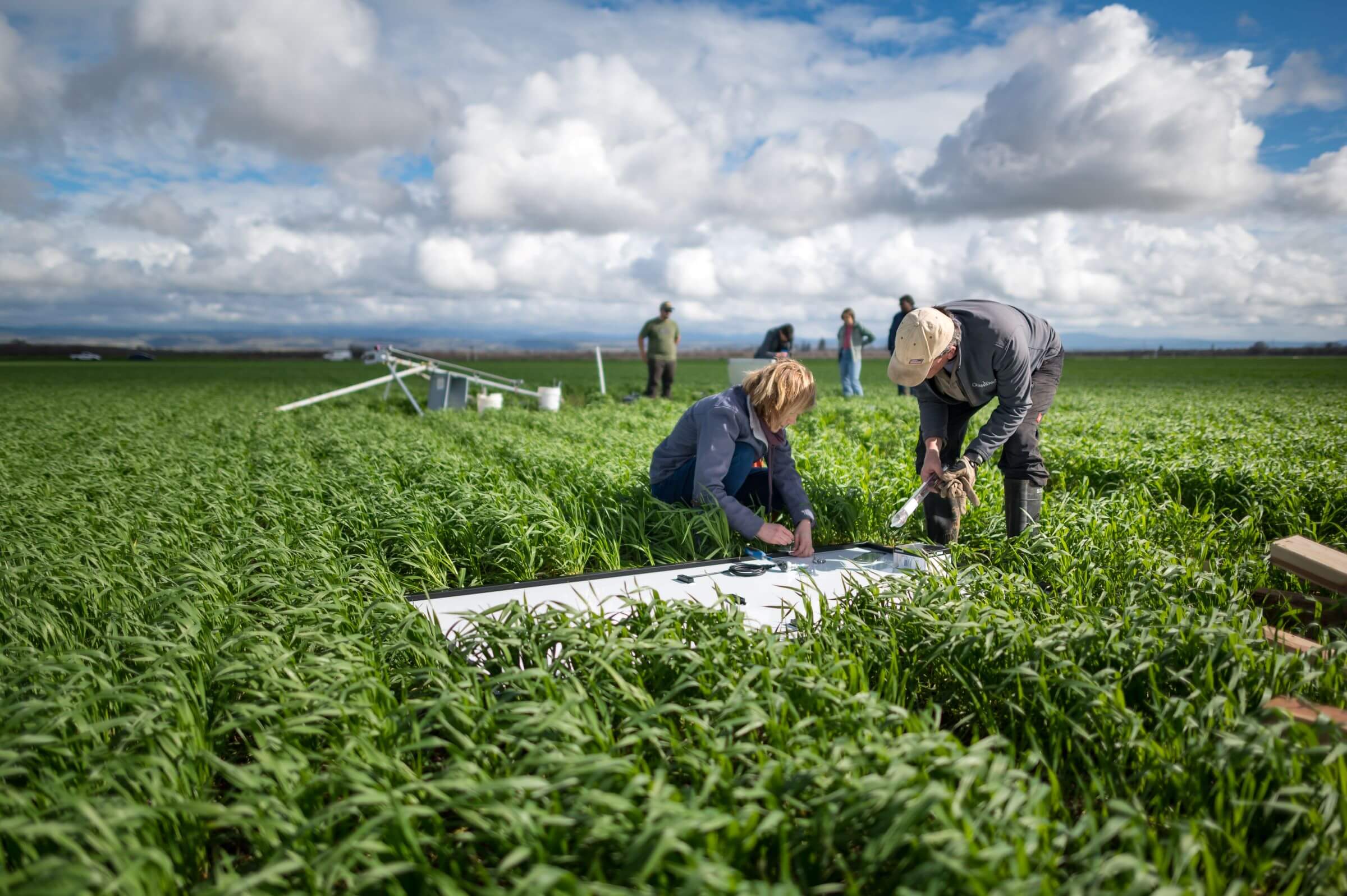
A Chico State team sets up a monitoring tower in an agricultural field. Photo credit: Jason Halley
Chico State’s
Center for Regenerative Agriculture and Resilient Systems (CRARS), along with the College of Agriculture, College of Natural Sciences and partner institutions including Cal State East Bay, received nearly $6 million to research climate threats to agriculture in California, such as soil erosion, degradation and water availability.
“Climate change is upon us, and no one feels the effects more than production agriculture,”
CRARS Director Cindy Daley said. “It’s imperative that we develop more effective farming strategies that build resilience for future food security and create a climate-literate workforce, with the skills and knowledge to manage these changes into the future.”
The
Soil Carbon Accrual Project compares the impacts of conventional farming practices and regenerative farming on environmental factors like levels of carbon, nutrient density and microbial diversity in the soil, as well as water usage and economic return.
Developed with the Chico State
Geographical Information Center, the California Agriculture Resiliency Index uses sustainability factors like water resources, soil quality and land use to predict how well the state’s agricultural regions will remain climate resilient and will support diverse farming practices in the future.
Finally, the
Technical Assistance Provider Training Program and Professional Certificate Program in Smart/Regenerative Agriculture Practices and Implementation prepare expert leaders to help California navigate the transition to climate-smart farming practices.
Collaborative of Native Nations for Climate Transformation & Stewardship | San Diego State
Co-led by San Diego State and the Climate Science Alliance, the
Collaborative of Native Nations for Climate Transformation & Stewardship (CNNCTS) brings together Tribal nations, government agencies and universities, including Cal State Long Beach, to help establish a model for indigenous-led land stewardship to improve the state’s climate resilience. CNNCTS secured a $7.1 million grant through SDSU to study environmental conservation and management methods.
“Tribal communities have always been resilient in the face of change, and this project is creating an opportunity for them to be at the forefront by sharing and demonstrating the value of the work that they’ve already been doing,”
said Megan Jennings, co-director of the
SDSU Institute for Ecological Monitoring and Management.
First, CNNCTS will test the indigenous practices of cultural burning and tree cutting to restore forests, reduce the effects and spread of invasive insects like the goldspotted oak borer, and mitigate the risk and damage of wildfires.
Second, the funds will help CNNCTS Tribal partners establish demonstration sites to instruct others in land restoration. For example, the Viejas Band of Kumeyaay Indians set up a greenhouse to cultivate seeds and plants that can restore areas damaged by wildfire, while the Pala Band of Mission Indians are operating a greenhouse to encourage people to plant home gardens.
Establishing Drought Resilient Grassland Restoration Networks in California | Cal Poly Humboldt
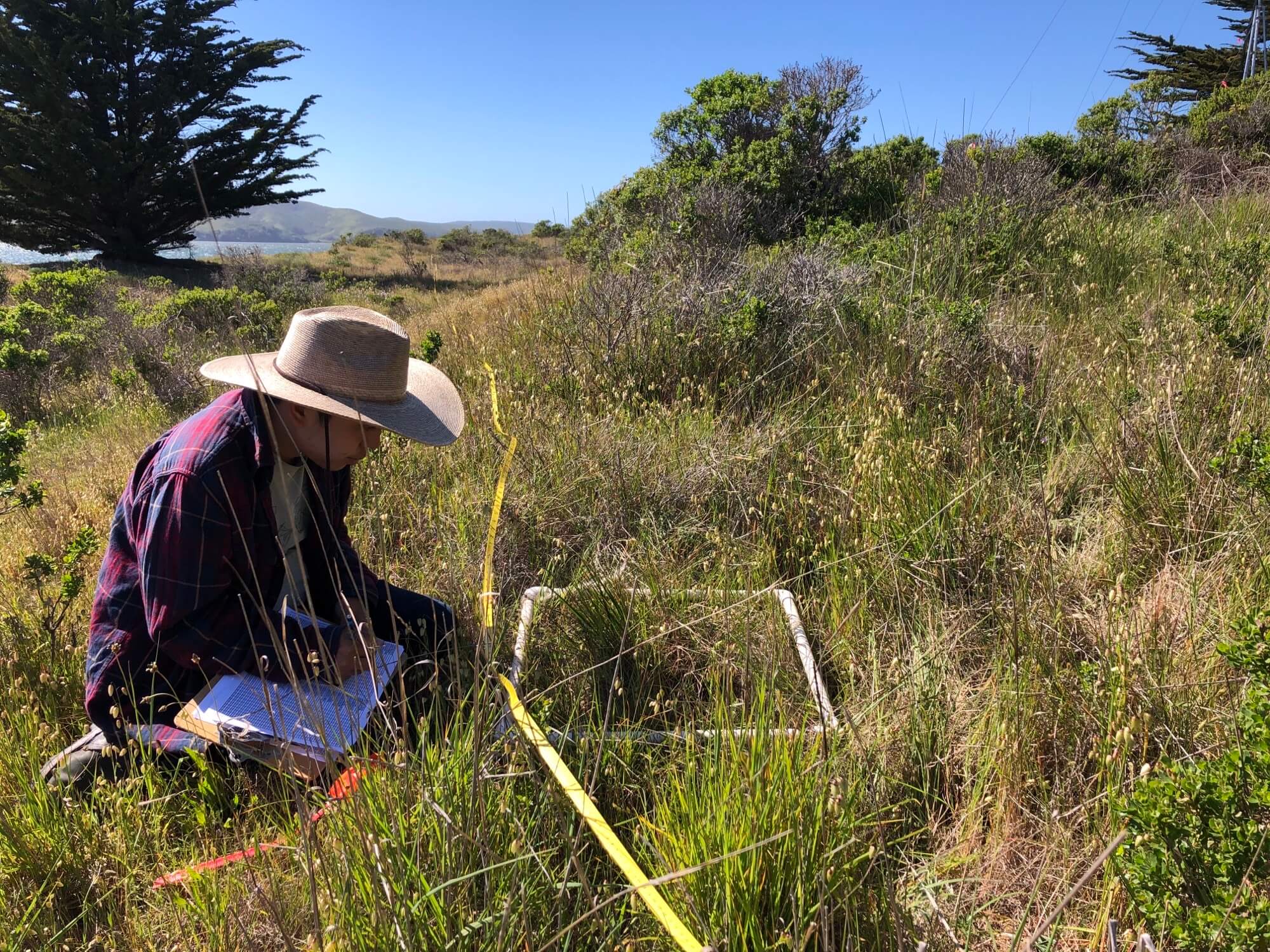
Cal Poly Humboldt Professor Justin Luong conducts research in a grassland area.
Grasslands make up 25% of land use in California and are integral to cattle ranching in the state—as well as natural processes that protect the ecosystem and industry like carbon and water storage, flood mitigation and food production for livestock.
Awarded with $1.5 million, a Cal Poly Humboldt-led team—that also includes Cal Poly San Luis Obispo, Chico State, the Wiyot Tribe and other universities, agencies and organizations—will develop restoration methods to make grasslands climate resilient and ensure they continue supporting native species.
The team will create the
Grassland Restoration Action, Science, and Stewardship Network (GRASS-Net) to gather and share best practices around grassland restoration as well as develop a climate-smart
restoration toolkit that includes key considerations for site assessment and plant selection.
“Establishing collaborative connections through a state-wide network of restoration practitioners at various agencies will help promote information sharing for ecological restoration of California grasslands,” says Justin Luong, Cal Poly Humboldt assistant professor of rangeland management. “Collaborative efforts can increase the use of under-studied biodiversity to promote climate resiliency and soil carbon.”
Improving Climate Change Resilience by Increasing Capacity for Northern California Tribal Fisheries | Cal Poly Humboldt
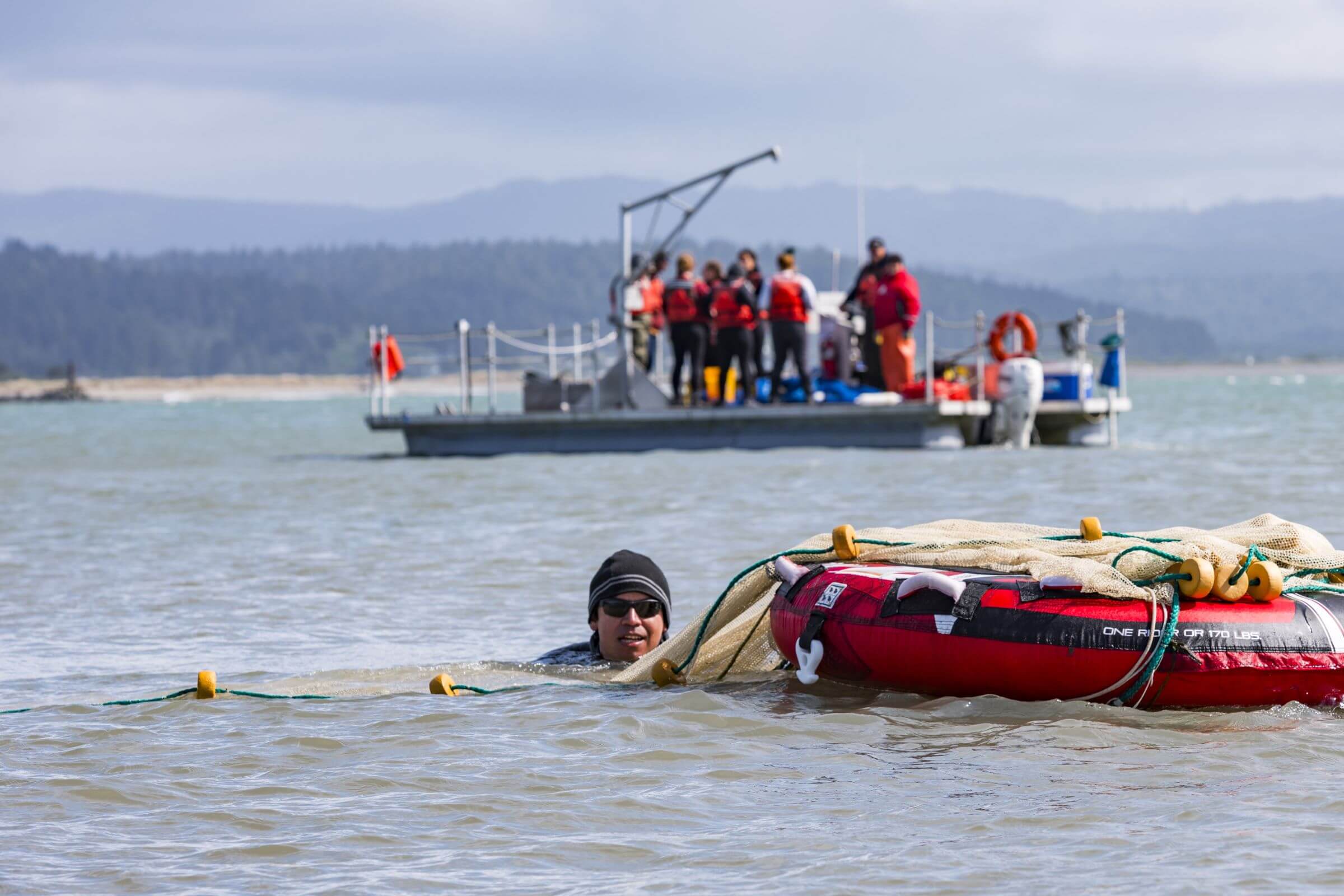
Cal Poly Humboldt Professor Jose Marin Jarrin working at the fisheries in Humboldt Bay during a Fisheries Icthyology course.
With a $1.1 million grant, another Cal Poly Humboldt team will work with Tribal and government partners to promote better research and monitoring of fisheries on the northern coast of California that cultivate fish species significant to local Tribes.
“This project is powerful because it’s centered around the Tribes; they decide what to study and where, and how to spend the funds, while university and U.S. government staff provide support,”
said Jose Marin Jarrin, Cal Poly Humboldt fisheries biology professor.
While these fisheries are vulnerable to effects of climate change like rising sea levels, increased ocean temperatures, pollution and extreme weather events, their monitoring has been overlooked due to a lack of funding and the area’s isolated location. The new research will gather data on the fish populations and their habitats, allowing for better management of the fisheries. The researchers will then share their findings with partners, the scientific community and the public.
Sustainable Land Initiative | Cal Poly San Luis Obispo
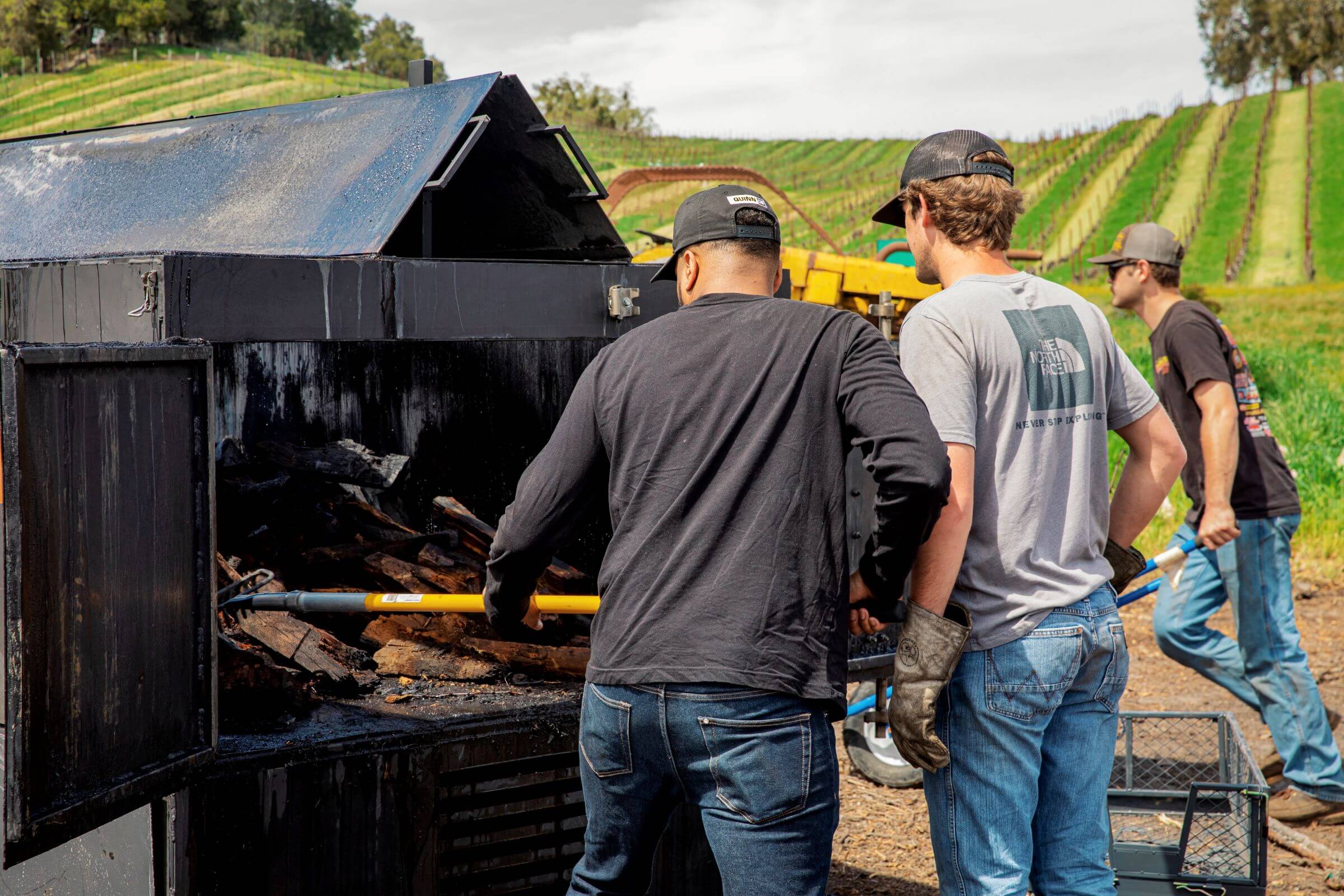
A team from Cal Poly San Luis Obispo’s Initiative for Climate Leadership and Resilience tests a kiln to produce biochar, charcoal made from plant matter that helps soil store carbon dioxide.
The
Initiative for Climate Leadership and Resilience (ICLR) at Cal Poly San Luis Obispo and its partner the Upper Salinas Las Tablas Resource Conservation District will use its $1.75 million grant to launch the Sustainable Land Initiative to implement climate-smart agriculture in the Central Coast of California.
“This funding will help provide effective strategies, tools, education and support toward achieving long-lasting benefits for our climate, crop production and the sustainability of our land,”
ICLR Director Erin Pearse said. “Agriculture has the unique potential to be not just carbon-neutral, but actually carbon-negative, by removing carbon from the atmosphere—and much more economically and much more safely than anything mechanical.”
The initiative will help local farmers implement climate-smart agriculture practices like using cover crops, specialized farm equipment and compost. In turn, these practices will help capture more carbon from the air in the soil, reduce water use, decrease fertilizer use and run off, increase crop production and make the farms more climate resilient overall.
In addition, the researchers will develop monitoring methods to quantify the efficacy of the climate-smart practices implemented.
Advancing Climate Resilience through Youth-led Action Research in Oakland, CA | Cal State East Bay
Supported by a
$1.94 million grant, Cal State East Bay, San Francisco State, UC Berkeley and other partner organizations are equipping the next generation of leaders for climate advocacy.
“It is critical to engage youth in communities that are disproportionately affected by climate extremes and industrial pollution in research and advocacy because their experiences are routinely ignored and overlooked by the academy and policymakers,” says Tony Marks-Block, CSUEB assistant professor of anthropology, geography and environmental studies. “When they are given opportunities to generate data and take action to create climate justice, the crux of oppressive systems becomes more evident.”
The project will engage about 400 middle and high school students in Oakland’s Interstate 880 corridor, an area that has been identified as a disadvantaged community with high levels of pollution. Participating students will help identify and promote climate-related actions—including assessing their communities’ current infrastructure, determining actions that would reduce pollution and increase climate resilience, developing strategies to monitor resulting changes, and sharing information on their findings and climate programs with community members and other stakeholders.
The efforts will be further supported by undergraduate interns at the three partner universities.
Rural Heat Islands: Mapping and Mitigating Farmworker Exposure to Heat Stress | San Diego State
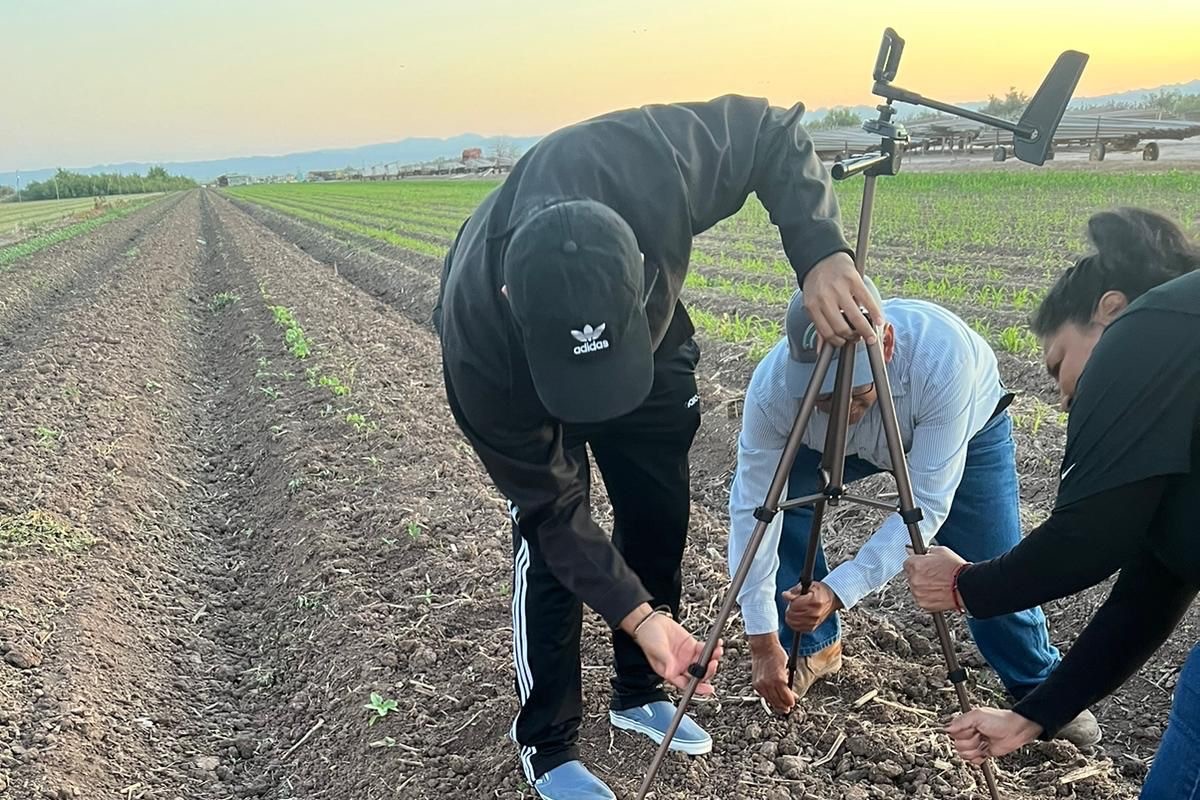
The SDSU team sets up a temperature sensor in an agricultural field.
Heat islands are areas that experience higher temperatures than surrounding areas, often due to manmade features. While urban heat islands have received significant attention, a team from San Diego State—working with the organization
Líderes Campesinas and UC Santa Barbara—aims to use its $1.9 million grant to research the heat stress effects of
rural heat islands on farmworkers in Imperial Valley. Temperatures in this county tend to surpass 100 degrees more than 100 days each year.
Beyond the base effects of climate change, irrigation and crop type, like an orchard versus a vegetable field, can drastically change the microclimate of agricultural areas across small spans of space and time—and crop changes and increased fallowing due to a lack of water availability in California also drive up temperatures. These conditions then make the farmworkers in this region particularly vulnerable to heat stress—resulting in acute heat illness and increasing cases of asthma and cardiovascular disease.
“There’s likely huge underreporting of heat illness, particularly in farmworker communities,” SDSU geography professor Trent Biggs said in
a UC article. “We need better documentation of actual heat stress frequency and severity.”
The team plans to map the region’s rural heat islands and trends; identify the relationship between heat stress, cropping patterns and the climate effects of the nearby Salton Sea; assess the farmworkers’ experiences of heat stress; compare the heat island maps between the agricultural fields and workers’ homes during both the day and night; develop ways to distribute the findings to workers and other stakeholders; and gather feedback from the community on those communication methods.
Implementing an Intervention to Reduce Heat Stress and Chemical Exposures | San Diego State
Also working with
Líderes Campesinas, another San Diego State research group was awarded $1 million to reduce the instances of heat-related illness and chemical exposure from the highly polluted Salton Sea among Imperial Valley’s farmworkers.
“No comprehensive heat stress or chemical assessments have been conducted in this region [before now],”
said Nicolas Lopez-Galvez, SDSU assistant professor of environmental health. “It is necessary to protect this vulnerable population by comprehensively assessing and urgently mitigating the levels of heat stress and agrochemical mixtures that farmworkers and their families living in this region are exposed to.”
The team will host workshops where community health workers will instruct 60 local workers in ways to avoid heat stress and prevent heat-related illnesses. The participants will also receive air cleaners or fan filters to decrease air pollution in their homes.
To test the efficacy of these measures, the researchers will conduct evaluations of the workers’ experiences of heat stress before and after the workshops. They will also evaluate the thousands of chemicals being released into the air from the Salton Sea by testing dust samples and silicone wristbands worn by participants.
The other CSUs that received funding—Long Beach, Monterey Bay, Northridge, Sacramento, San Francisco and San José—are involved as partner institutions on projects led by other CSU or UC teams.
Learn more about research at the CSU.